DMC/GMS Field Trip March 2024
If you have any questions about field trips send email to Field Trip emailDMC/GMS Field Trip
Metagranite in Georgia
Saturday, March 24, 2024
The Southeast Federation of Mineralogical Societies (SFMS) has a field trip sharing program called the DMC in which GMS participates. Every month, one club in the program hosts a field trip for the other clubs, so club members get at least one field trip per month, plus they get to visit a variety of sites all over the southeast. This time, it was our turn to host.
Members of several clubs gathered together on a slightly soggy Saturday to collect Corbin metagranite, i.e., metamorphosed granite named for a small community in Georgia. This rock is considered to be the oldest rock being quarried in Georgia, dated at about 1.1 to 1.2 billion years old. The most sought-after specimens consist of large white microcline feldspar crystals surrounded by coarse gray plagioclase feldspar and thin lines of shiny black muscovite mica, but the star of the show is the quartz. When the rock is wet or has been polished, the quartz exhibits a deep blue color that is caused by microscopic titanium minerals. In addition to making the metagranite attractive, the blue color is an indication of the age of the rock, as blue quartz is rarely seen except in rocks that are a billion years old [1].
Properly attired in hardhats, safety glasses, high visibility vests, and footwear with good ankle support, attendees examined several samples from the quarry before we received a thorough safety talk. Then, quarry personnel led us into an area of the quarry not often accessible to us. Everyone was eager to explore the new territory, so they got to work quickly and were showing me specimens within minutes of our arrival. Despite some concern about wet weather in the days preceding the trip, the rain was truly an asset. Not only did it wash off the rocks, but it also provided some convenient puddles where we could wash them even more to evaluate their color and to look for other minerals.
Besides the beautiful blue metagranite, we found rocks consisting of so much pink garnet that the whole rock can look pink. The mica in those rocks is brown and occurs as tiny crystals peppered throughout, which is very different from the distinct veins of black mica that outline the feldspar crystals in the metagranite. Many members noticed boulders with a thin layer of a green mineral in what appears to have been contact areas between rocks. Pyrite was also seen in the metagranite as veins or dotted about in small clusters. Just as the day was ending, we encountered a boulder with metagranite on one side and garnet rock on the other side. A distinct line divided the two, and along that boundary, the metagranite also had garnets in it. As we contemplated that, we noticed another curious boulder nearby. It was mostly metagranite with what appeared to be some of the garnet rock embedded in it (xenolith). Xenoliths would indicate older rock was engulfed by the magma that formed the granite. A bit of research after the trip confirmed this thought. The xenolith is most likely from the Rowland Spring formation, which is older than the Corbin metagranite, and material from the formation has been documented as xenoliths in the metagranite [2].
Many thanks to quarry personnel for graciously allowing us to visit an area so important to the geology of Georgia. They were so kind and generous, bringing us samples and keeping us safe. Field trip participants were very respectful of the opportunity granted to them and also kept an eye on one another. Thank you to Charles for arranging this trip and for providing bananas, granola bars, trail mix, and bottled water to keep us energized and hydrated all day.
References:
[1] Bill Witherspoon, Georgia Rocks, accessed 25 March 2024, http://www.georgiarocks.us/corbin/index.htm
[2] USGS, Geologic Unit: Rowland Spring, accessed 04 April 2024, https://ngmdb.usgs.gov/Geolex/UnitRefs/RowlandSpringRefs_3646.html
Lori Carter on behalf of Charles Carter
e-mail: Field Trip email
Photos by Lori Carter

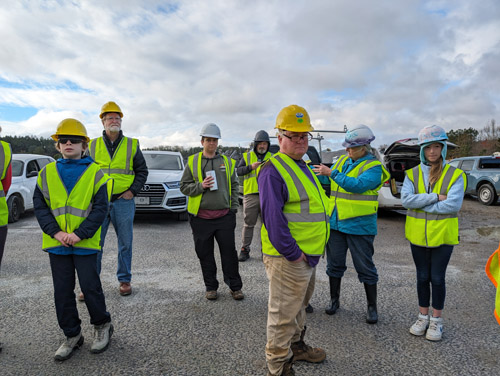
Security talk and equipment check
Photos by Lori Carter
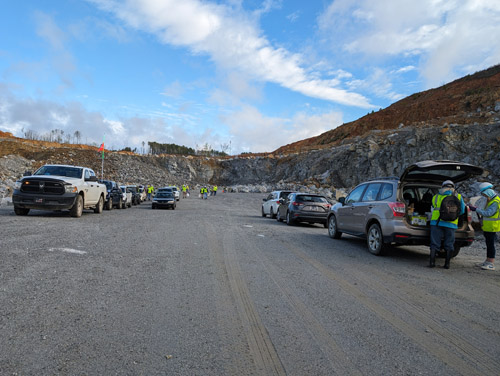




Boulders of beautiful rocks everywhere
Photo by Lori Carter

For a moment I felt like the Mars Rover Opportunity, gazing over terrain filled with potential
Photo by Lori Carter

Puddles are useful here!
Photos by Lori Carter






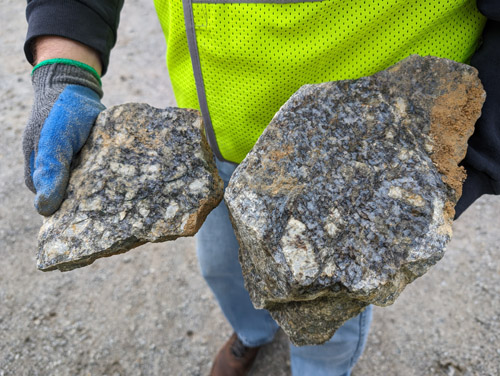
Examples of the metagranite with blue quartz
Photos by Lori Carter

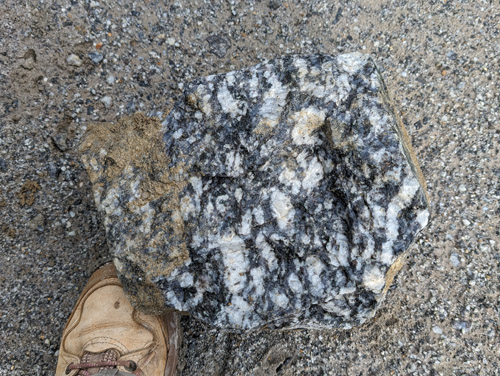
A couple of big samples
Photos by Lori Carter



A large boulder with a fresh break shown dry (top), wet (middle), and close-up (bottom)
Photos by Lori Carter


Specimens that are almost entirely blue
Photos by Lori Carter

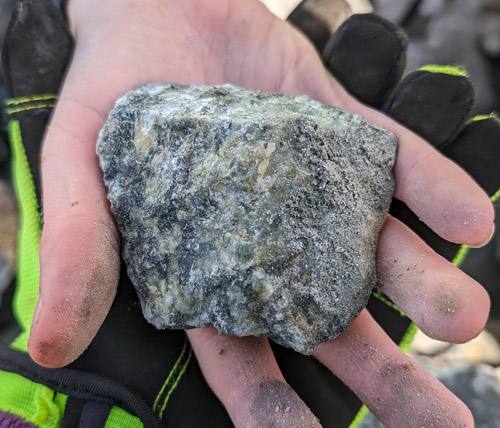
A junior member found these pieces that have a green hue
Photo by Lori Carter

The feldspar in this specimen is orange
Photo by Lori Carter


Examples of rocks that consist of mostly garnet
Photos by Lori Carter
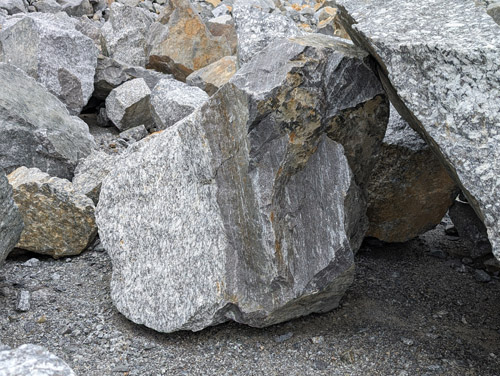

The boulder that is half metagranite and half rock full of garnets.
Bottom image is a close-up of the boundary between the two.
Photos by Lori Carter


The metagranite boulder that appears to have a xenolith of the garnet rock.
Note the thin layer of green mineral on the left side of the boulder too.
Click below for field trip policies

Copyright © Georgia Mineral Society, Inc.
